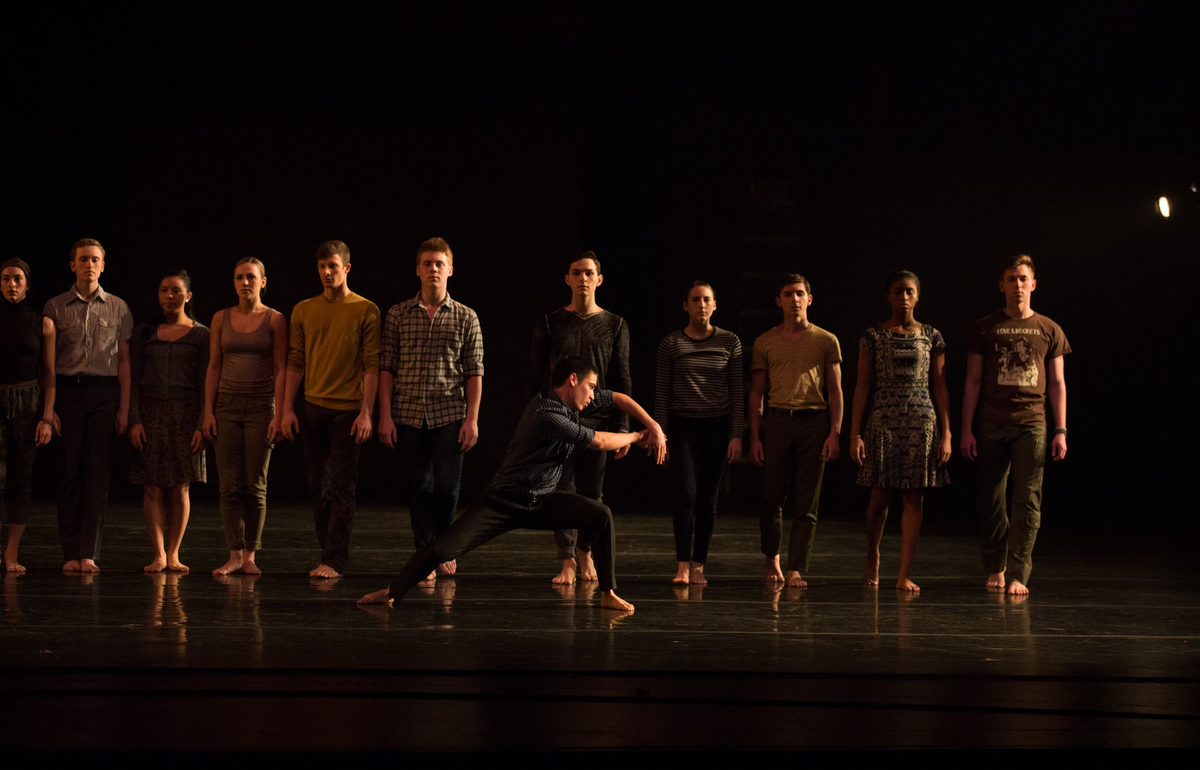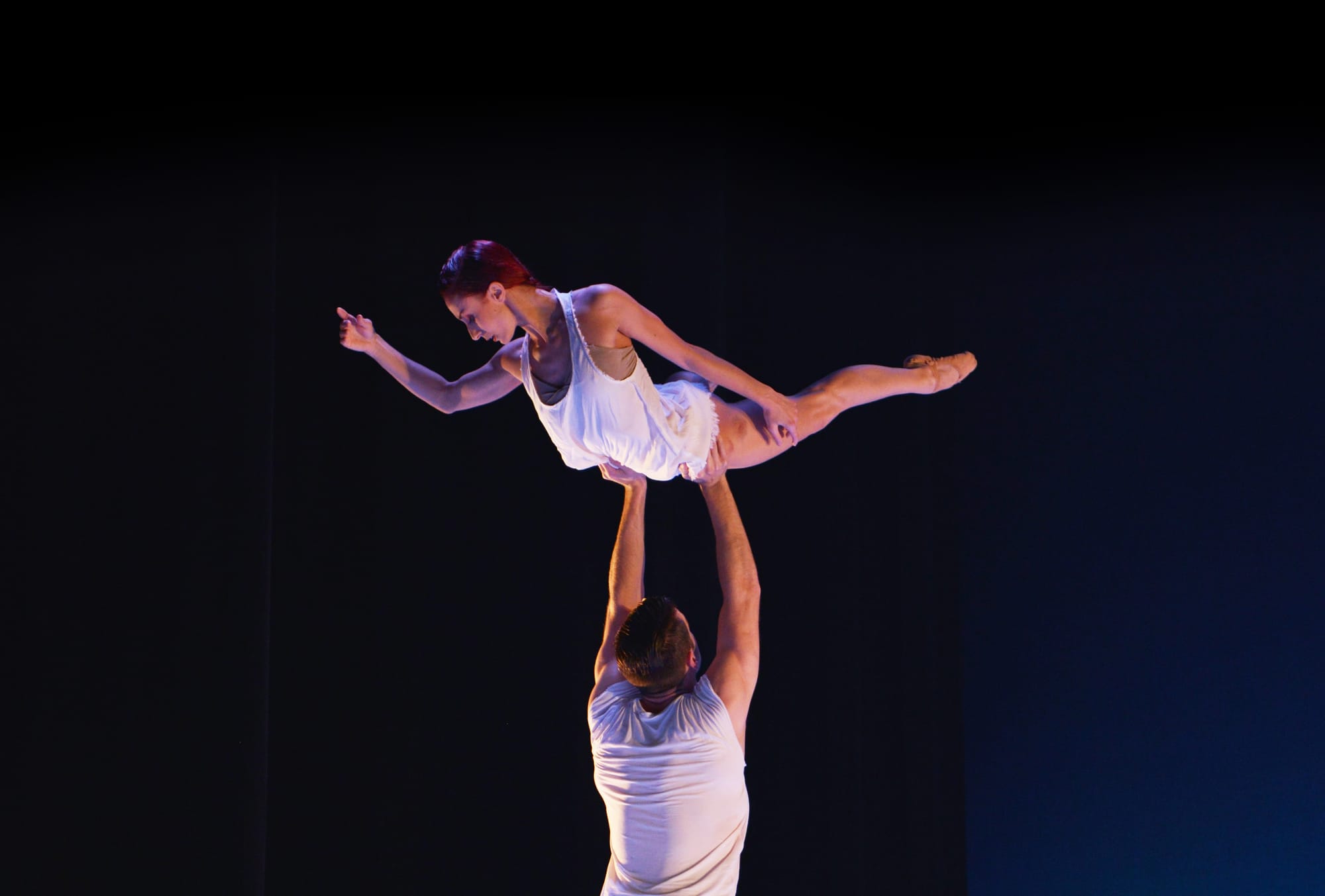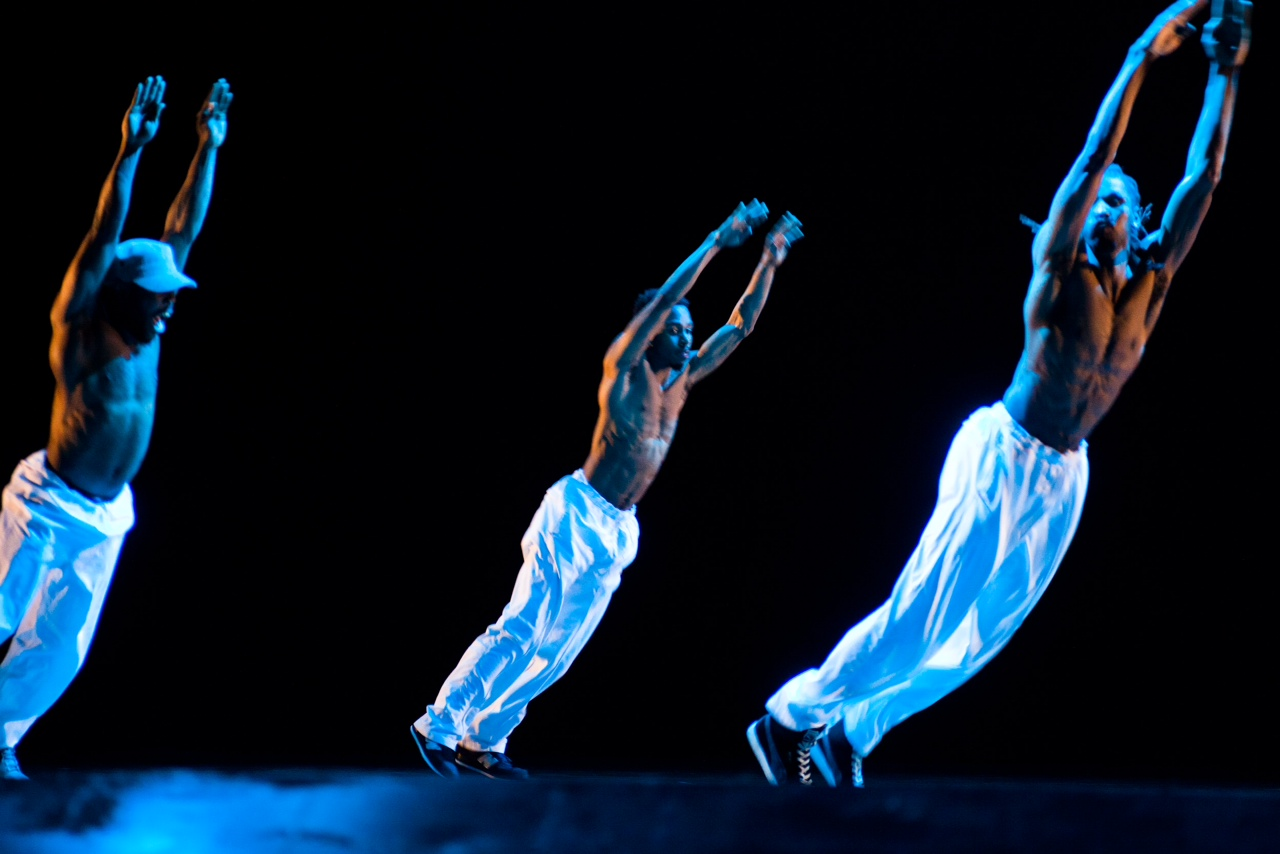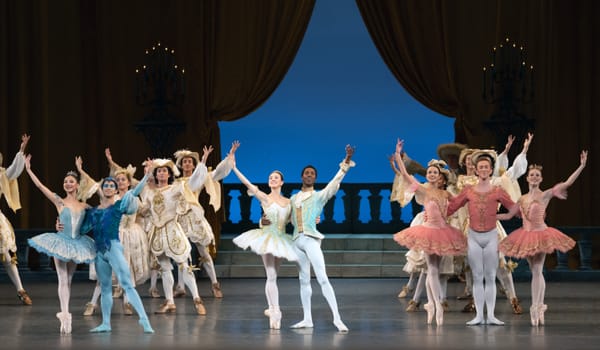In Tension

"Torrent,” “Ostinato,” “Closer,” “Students of the Asphalt Jungle”
Brian Brooks Moving Company with Juilliard Dance, The Australian Ballet, BJM- Les Ballets Jazz de Montréal, Rennie Harris Puremovement
Fall For Dance Festival
New York City Center
New York, NY
October 17, 2014
Fall For Dance festival’s fourth program was full of expressions that belie outward appearances. The two middle works, set to gentle, repeating live piano music of Bill Evans and Philip Glass respectively, were rich with content that was anything but placid and repetitive; the bookending pieces whirled in flux to energized accompaniment, but their substance was peacefully simple.
Photo of the Brian Brooks Moving Company with Juilliard Dance in "Torrent." Photo © Rosalie O'Connor
Brian Brooks’s 2013 creation, “Torrent,” set the night off with a chaotic flow of 26 dancers falling in and out of line with each other to Max Richter’s recomposition of selections from Vivaldi’s “Four Seasons.” The dancers streamed onstage to form single lines, sustaining the linear formations only for a moment before folding them backwards and seeping offstage like streams of sand. They broke off from the patterns for solos, duets, and group dances, and the stage was filled with countless random interactions and dialogues, all influencing their individual movements. In this tug and pull between conforming and random expressions, Brooks centered certain dancers’ movements around personal axes, while others’ movements revolved around external focal points. The scenes seemed chaotic, but the bustling world portrayed by Brian Brooks Moving Company and Juilliard Dance cast, dressed in what could well have been street clothing, nonetheless felt familiar and comfortable – like a day in the life of any one of us, shifting ever so slightly with different encounters and observations. Like in life, people came and went, tension forming and diffusing, and then with one giant step, the dancers all fell back toward darkness.
Tim Harbour's "Ostinato," the program’s only world premiere, followed in stark contrast to the opening piece. The minimalist grey costumes of the three Australian Ballet dancers, the repeating progression of Bill Evans’ “Peace Piece" played by Brian Cousins, and the program notes’ promise that a “man and woman together onstage is a story – and a mystery” set-up the work. The crisp, uncomplicated choreography, laced with intermittent jazzy flicks of the wrist here and pops of the shoulder there to go along with the music’s jazz beat, allowed ample space for the tensions to build among the dancers.

The men, Daniel Gaudiello and Ty King-Wall, began the ballet performing identical movements. The similarity of their physical expression forced the eye to search for differences – a higher leg elevation from Gaudiello, a more sustained tombé from King-Wall. None however seemed to markedly distinguish the men, who remained alike, like the chords of the accompanying music. Robyn Hendricks was all it took to upset the uniformity. After briefly observing the men from the top of stage left, she chose to join them. The dancing, even when all three were doing the same steps, possessed a previously unobserved uncertainty, time and again forcing the men out of the patterned movement and into interactions with her. Unexpectedly, it wasn't a love triangle that unsettled the dynamic. At least not an obvious one. Hendricks's interest may have wandered as she danced with each man without fully abandoning either -- partnered in arabesque with one, she would lean sideways to look at the other behind him -- but her preference was never revealed, and indeed she never made a choice. At the end, she moved to walk away, only to return to the two men, the three of them leaning forward in a tentative tombé ending the piece, but not their story.
Perhaps because it bore some similarity to “Ostinato,” for a nearly decade-old ballet Benjamin Millepied’s 2006 work “Closer” felt remarkably fresh. Throughout the dance, Les Ballets Jazz de Montréal’s Céline Cassone and Alexander Hille were never wanting for physical proximity, but entangled in their connected movements was a whole range of emotional drama -- first a deep appreciation for their closeness, then a perceptible distance which they tried to understand, expand, then erase. Philip Glass’s repetitive “Mad Rush,” deftly performed live on the piano by Brigitte Poulin, reinforced the tensions across these phases, and the dancers’ technique and ability to perform this grueling piece almost seamlessly for 18 minutes allowed for the focus to stay on the content of their movements.
Cassone’s dancing was as dramatic as her look: her fiery red hair against the pure, light costumes and alternating pastel background lighting was a perfect metaphor for the drama she brought to the piece. In one of the first steps, she exploded from a deep plié into Hille’s arms in a back-bended lift, freezing the moment for a few seconds, and making the intimacy of their embrace almost palpable. In a later lift Cassone rotated to face the audience with a piercing look, signaling there were tumultuous times ahead for this couple. Unlike Cassone, Hille’s dancing was all romance. Throughout the piece he was attentive to her every step, and when their later embrace spurred the movements into chaos and Glass’s score started flying with intensity, Hille’s struggle was to preserve the fleeting closeness as Cassone seemed to wish to pull away. He ultimately succeeded, and as the lights dimmed on the couple lying down on the floor next to each other, they seemed closer than when they started.

The final work, Rennie Harris’s 1993 “Students of the Asphalt Jungle,” opened to a drum beat and a piece of Dr. Martin Luther King Jr.’s famous “I Have A Dream” speech. The dancers, bare-chested and wearing only white cargo pants and sneakers, walked onstage, passing each other, then embraced. The music’s energy shifted, stirring a kaleidoscopic display of an electrifying mix of hip-hop, break dancing, and homages to other dancing styles, complete with jazz moves, tap moves, shoulder popping and every b-boy acrobatic flip, spin, balance and slide (including a head-slide!) you could imagine. The crowd ate it up, but the work was not just about showmanship. Inspired by African dances (though not relying on that specific vocabulary) the piece celebrated the African roots of the many dance styles prominent today, and with its pure joy of dancing made the audience feel part of it. When the dancing ended, the eight performers of Rennie Harris Puremovement only reinforced that sense of unity by leading the standing audience that didn’t want them to leave in a rhythmic clap, thanking the crowd for their ovation and holding up peace signs.
copyright © 2014 by Marianne Adams



